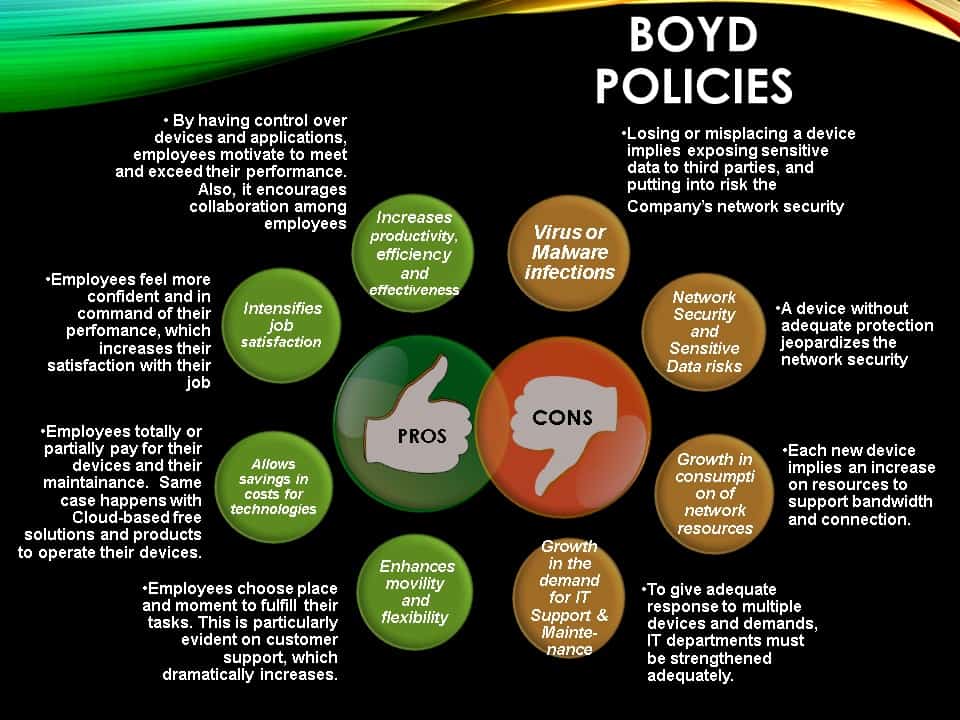 What it was just a trend until recently, is now a consolidated practice in many enterprises. BYOD Policies (Bring Your Own Device), are now the most extended way to work on and offline. BYOD Policies offer lots of advantages to keep on track with technology.
What it was just a trend until recently, is now a consolidated practice in many enterprises. BYOD Policies (Bring Your Own Device), are now the most extended way to work on and offline. BYOD Policies offer lots of advantages to keep on track with technology.
But before going deeper on BYOD Policies, we better define what are they, or what it takes to deploy them. According to Wikipedia:
Bring your own device (BYOD)—also called bring your own technology (BYOT), bring your own phone (BYOP), and bring your own Personal Computer (BYOPC)—refers to the policy of permitting employees to bring personally owned devices (laptops, tablets, and smart phones) to their workplace, and to use those devices to access privileged company information and applications.
So, BYOD Policies are here to redefine the way we used to work until not so long ago. However, BYOD Policies didn’t appear magically. So, let’s give a look on how everything started.
How do BYOD Policies began?
Until recent times, it was pretty common that people had PCs at home. Nevertheless, those PCs usually weren’t as functional or powerful as their PCs at their workplaces. As consequence, enterprises usually assigned laptops, cellphones or other cutting-edge technology to make work easier for strategic employees.
This picture rapidly changed: The evolution of technology met common people with powerful devices, and sooner, enterprises and final users were using the same technology. In other words, enterprises weren’t the only capable to buy and deploy state-of-the-art technology.
Then, the unthinkable happened: The trend got inverted. For several reasons -budgetary issues and licenses among others-; enterprises noticed that updating their technology was more difficult as days passed by.
On the contrary, technology addressed to final users become more accessible in every possible aspect. Sooner and faster than enterprises, common people adopt and began to consume cutting-edge technology. Naturally, enterprises realized what was going on, and capitalized it.
Results are evident for everybody, especially on these days when remote working is the new trend: Enterprises and employees use BYOD Policies to make work easier, and improve the job performance. However, not everything is a bed of roses.
As you may suppose, bringing and using personal devices on the work environment imply creating and adopting new rules to the game to take out the best of their advantages, while diminishing and preventing their disadvantages. Let’s see then their pros and cons for your consideration.
BYOD Policies: Pros
Increase productivity
Employees feel more in control of their tasks when using their own devices and applications. This feeling has a positive impact over the employee’s attitude towards his or her work, which benefits the work atmosphere and improves the cooperation between co-workers.
Increase the employee’s satisfaction
In the same measure as BOYD Policies promotes the employee’s autonomy and control over his or her work, it also favors the employee’s satisfaction regarding the fulfillment of his or her work.
All these elements add brownie points to the employees’ general feeling of doing the best at their workplace.
Save money in costs for technology
Taking advantage of BYOD Policies help the companies to save money: As each employee pays totally or partially for his or her devices and their maintenance, the company saves a lot of money in technology.
Employees have more control over place and time to fulfil their work. This is to say, they may actually go out on vacations and keep on working from a hammock at the seashore, if they want to. This flexibility is particularly evident and convenient on Customer Attention and Technical Support.
BYOD Policies: Cons
Mobility and Security Risks
Working from personal mobiles devices such as tablets, smartphones or laptops allow the employees to choose the networks to connect. This faculty implies security breaches that may have been exploited by third parties.
Mobility also implies risks for losing or misplacing the personal devices, which compromises the company’s sensitive data. In few words, mobility implies security risks to be aware off.
Risk for Malware and Viruses
They go hand in hand with security risks for well-known reasons. Additionally, there are around what we know as war drivers and war walkers, who aren’t urban leyends but actual hackers that move from place to place, looking for every opportunity to strike.
Control and excessive Consumption of Network Resources
BOYD Policies imply extra demand of control as result of working in virtual environments. This is a direct consequence of relying on technology for work management from personal devices, which makes more complicated work integration.
Carrying on integration in virtual environments means a considerable increase in appropriations for the networks, taking into consideration that each new device demands a larger consumption of resources and bandwidth.
Demand on IT Support and Maintenance
Integrating more and more personal devices to business networks involves adding more staff hours to do what it takes for protection, and make things work. Also, each device requires different passwords, software and special maintenance to preserve the company’s assets, especially in terms of prevention.
Additionally to these disadvantages related to BYOD functionality, we found that integration may have a spin-off dark side: abuse of integration. When using personal devices to work, limits between personal things and enterprise get blurry and confusing.
On the next drawing, we appreciate the Pros and Cons on BYOD Policies:
When giving a deep look on this drawing, we appreciate a tiny intersection between pros & cons. Is on this spot where the challenges of setting limits and good practices reside: It’s always possible to keep track on work while respecting personal space. And this last sentece lead us to our conclusions.
What can we do to make the best of BYOD Policies?
We can do plenty to minimize risks and disadvantages while making the best of their advantages. The important thing is keep the focus with these 5 steps:
1. Control
We agree that BYOD Policies give to the employees more autonomy and freedom to work under their terms. However, it’s always a good idea to have some control over the applications and solutions used to give compliance to the company’s demands.
So, demand the instalation of especial tools and solutions as policy to implement standardization of processes. This measure encourages uniformity as good practice. And speaking about good practices…
2. Establish Good Practices
In terms of BYOD Policies, good practices cover from automatic blocking to regular change of passwords in each device. It also includes notifying the company in case of lossing or missplacing the device, so the personnel in charge of security may proceed to deactivate their associated packages.
These simple but effective measures help a lot to protect the enterprise’s sensitive data, and contribute to ring-fence the security network.
3. Compile and apply coherent policies
Make your employees to read and sign a BYOD Policies contract. You can add it to your Confidentiality and non-competition agreements, or creating an extra contract to be subscribed as mandatory term for the working relationship.
Keep in mind: With freedom comes responsibility. Your employees must be capable to honor this commitment.
4. Educate and support
Make sure your employees understand and avoid security risks and even more: Make them understand the real reasons behind security measures.
Organize informal talks and complement them with special campaings to promote consciousness on BYOD Policies and security risks.
5. Implement solutions for Mobile Devices Management
These solutions gives you the capability to manage multiple devices and applications. They also provide a panoramic view on what’s going on with every single device, speaking in security terms.
Of course, there are plenty applications and solutions designed for this purpose. However, you need to adopt the best tool that responds better to your business’ particular requirements. If you have any doubts regarding the best option for your enterprise, consult with the experts.
In GB Advisors we have solutions tailored to your needs, just check for our options to help you choosing the best option to protect your assets while taking advantage of BYOD Policies.





